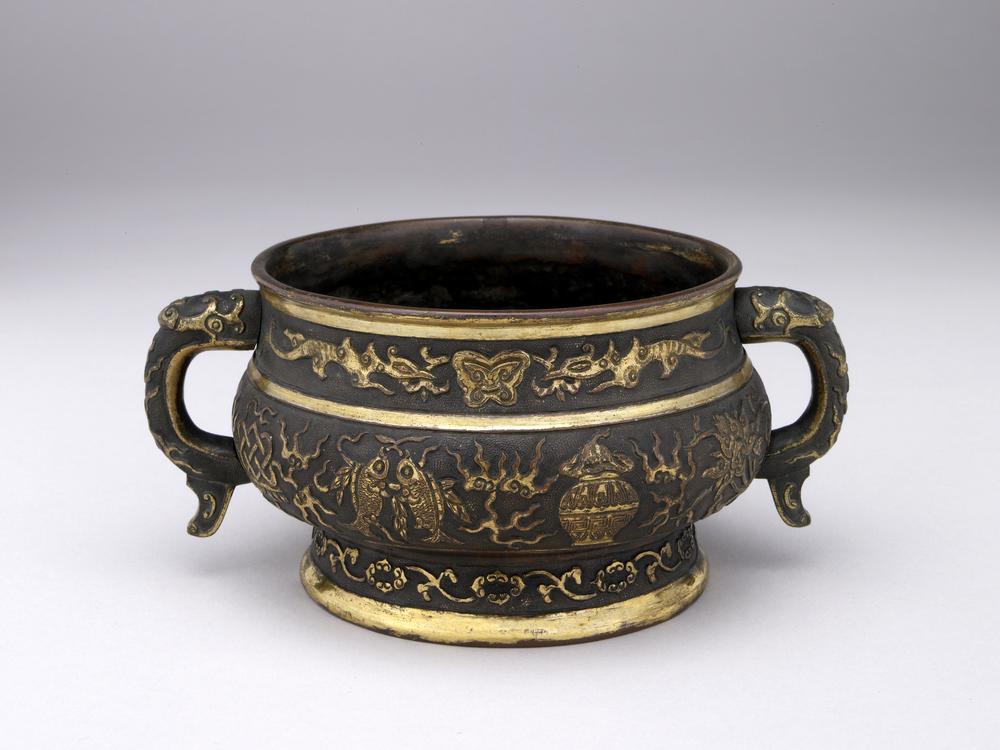Period:Unknown Production date:9thC-10thC (circa)
Materials:paper, 紙 (Chinese),
Technique:painted
Subjects:religious object 法器 (Chinese)
Dimensions:Height: 68.70 centimetres (Image in mount) Height: 44 centimetres (Image) Width: 51 centimetres (Image in mount) Width: 30.70 centimetres (Image)
Description:
Painted diagram, inscriptions identifying various parts of an altar, prepared for recitation of the Uṣṇīṣavijaya dhāraṇī. The circular bowls on the altar are for incense and water, and there are also lamps and vases. An image of the Buddha is placed at the centre. The officiatiant is seated at the south side of the altar (the bottom of the diagram) with another incense burner (or burners) behind him. Ink on paper.
IMG
![图片[1]-painting; mandala; 繪畫(Chinese); 曼陀羅(Chinese) BM-1919-0101-0.174-China Archive](https://chinaarchive.net/Unknown/Paintings/mid_00000083_001.jpg)
Comments:Zwalf 1985Reciting this spell was believed to destroy the effects of evil ‘karma’; in the ‘Uṣṇīṣavijayā dhāraṇī sūtra’, translated into Chinese c. AD 676, the Buddha teaches it to the King of the heaven of the Thirty-three Gods to prevent his descent into hell. The circular bowls on the altar are for incense and water, and there are also lamps and vases. An image of the Buddha is placed at the centre. Inclusion of the names Bhaiṣajyarāja, Bhaiṣajyasamudgata, Bodhisattvas of Healing, together with Avalokiteśvara and Mahāsthāmaprāpta, suggests that the diagram was more likely intended for the recitation of a ‘dhāraṇī’ connected with meditation on the first two Bodhisattvas. The officiating Tantrist is seated at the south side of the altar (the bottom of the diagram) with another incense burner (or burners) behind him.
Materials:paper, 紙 (Chinese),
Technique:painted
Subjects:religious object 法器 (Chinese)
Dimensions:Height: 68.70 centimetres (Image in mount) Height: 44 centimetres (Image) Width: 51 centimetres (Image in mount) Width: 30.70 centimetres (Image)
Description:
Painted diagram, inscriptions identifying various parts of an altar, prepared for recitation of the Uṣṇīṣavijaya dhāraṇī. The circular bowls on the altar are for incense and water, and there are also lamps and vases. An image of the Buddha is placed at the centre. The officiatiant is seated at the south side of the altar (the bottom of the diagram) with another incense burner (or burners) behind him. Ink on paper.
IMG
![图片[1]-painting; mandala; 繪畫(Chinese); 曼陀羅(Chinese) BM-1919-0101-0.174-China Archive](https://chinaarchive.net/Unknown/Paintings/mid_00000083_001.jpg)
Comments:Zwalf 1985Reciting this spell was believed to destroy the effects of evil ‘karma’; in the ‘Uṣṇīṣavijayā dhāraṇī sūtra’, translated into Chinese c. AD 676, the Buddha teaches it to the King of the heaven of the Thirty-three Gods to prevent his descent into hell. The circular bowls on the altar are for incense and water, and there are also lamps and vases. An image of the Buddha is placed at the centre. Inclusion of the names Bhaiṣajyarāja, Bhaiṣajyasamudgata, Bodhisattvas of Healing, together with Avalokiteśvara and Mahāsthāmaprāpta, suggests that the diagram was more likely intended for the recitation of a ‘dhāraṇī’ connected with meditation on the first two Bodhisattvas. The officiating Tantrist is seated at the south side of the altar (the bottom of the diagram) with another incense burner (or burners) behind him.
© Copyright
The copyright of the article belongs to the author, please keep the original link for reprinting.
THE END
![[Qing Dynasty] British female painter—Elizabeth Keith, using woodblock prints to record China from the late Qing Dynasty to the early Republic of China—1915-China Archive](https://chinaarchive.net/wp-content/uploads/2022/11/image-191x300.png)




